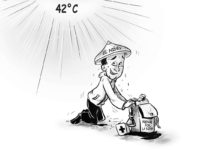[av_one_full first min_height=” vertical_alignment=” space=” custom_margin=” margin=’0px’ padding=’0px’ border=” border_color=” radius=’0px’ background_color=” src=” background_position=’top left’ background_repeat=’no-repeat’ animation=”]
[av_heading heading=’PEOPLE POWWOW | Reminiscing our New Zealand tour’ tag=’h3′ style=’blockquote modern-quote’ size=” subheading_active=’subheading_below’ subheading_size=’15’ padding=’10’ color=” custom_font=”]
BY HERBERT VEGO
[/av_heading]
[av_textblock size=” font_color=” color=”]
Thursday, July 6, 2017
[/av_textblock]
[av_textblock size=” font_color=” color=”]
ONE YEAR ago between June and July 2016, we – including Danny Fajardo, Rodolfo Jarumahum and this writer – toured several cities of New Zealand to experience “happiness.” That cold and isolated country more “down under” than Australia has consistently graced the United Nations’ annual list of “10 happiest countries.”
Having already written a feature story about it, I would like to dwell this time on memorable moments that freed us from the congestion, pollution, criminality and heavy traffic prevalent in Philippine cities.
Because of its low population of 4.5 million people sharing a land area of 269,000 square kilometers – which is almost as big as the Philippines’ 300,000 sq. km. – everybody has food, clothing and shelter. Compare that to our population of 100 million Filipinos, some of whom are the “urban poor” who can’t make both ends meet.
The increasing number of foreign tourists who enter New Zealand – around 3.5 million recorded in 2016 – is an indicator that tourists would eventually outnumber permanent residents.
But while New Zealand could depend on tourism alone for sustainable economic productivity, it actually relies much more on agriculture and livestock. The amazing sheep population swings from a low of 30 million to a high of 70 million heads; beef cattle, from 10 million to 20 million.
Arriving at the Auckland International Airport, which is smaller but more orderly than our Ninoy Aquino International Airport, we were welcomed by ladies giving away booklets, magazines and brochures with maps and articles promoting tourism havens.
Outside the terminal, we sat on a bench wondering how to get to our first destination, Kiwi Hotel. Although we could see a score of taxi cabs with drivers just standing by while patiently waiting to be called, we opted to ask a fellow Filipino for advice. He suggested that we take a bus. It did not take long for one bus to stop where we were. The bus was one of the airport buses that would drive tourists for free to any hotel within the city of Auckland.
The second day, we bus-rode back to the airport, where we would be picked up by our hosts – Mike Adger and his Filipina wife Ruby – for a three-hour car ride to their home in Tauranga City.
The ride gave us a moving view of farm lands growing lettuce, kiwifruit, orange and lemon; and of vast green fields where thousands of cows and sheep were grazing. Wow, if that scene were replicated in the Philippines, no Filipino would suffer hunger.
We also passed by big trucks loaded with giant logs. Hard wood is one of New Zealand’s profitable exports.
We lived with the Adger house in Tauranga City on an eight-lane highway across the Bay of Plenty. White-painted parking spaces on the entire beach-side of the road were available to all motorists free of charge.
One of our daily routines was walking along the beach for coffee or lunch at any of the city’s restaurants, where we would spend hours reading newspapers. Not once did we read about killings, kidnappings or thieveries.
A number of times we walked to a bank to exchange US dollars into NZ dollars. There were only two lady tellers in that bank, but not one security guard.
The only one time we saw uniformed police officers biking around, we wondered why they were not always visible. Our host Ruby laughed, “Days pass by when nobody harms anybody.”
The availability of a spacious public comfort room on every street corner struck us as another “novelty.” No fee was charged us for its use.
There was also only one time when we saw a male beggar squatting on the street, and he was not even a Kiwi or NZ native; he was a lazy foreigner, Ruby said.
The beautiful homes competing for attention seemed to indicate the homeowner’s high standard of living. Ruby explained that the government strictly enforces a minimum wage of NZ $15 per hour, which is equivalent to US $10.50.
We spent our most memorable NZ day at Matamata rolling hills, location of the famous movies Lord of the Rings and The Hobbits. The movie set known as Hobbiton, with its make-believe underground homes, attracts an average of 500 paying tourists daily.
Do we have any city in the Philippines that could be as safe as any city of New Zealand? None, unfortunately. (hvego31@gmail.com /PN)
[/av_textblock]
[/av_one_full]



